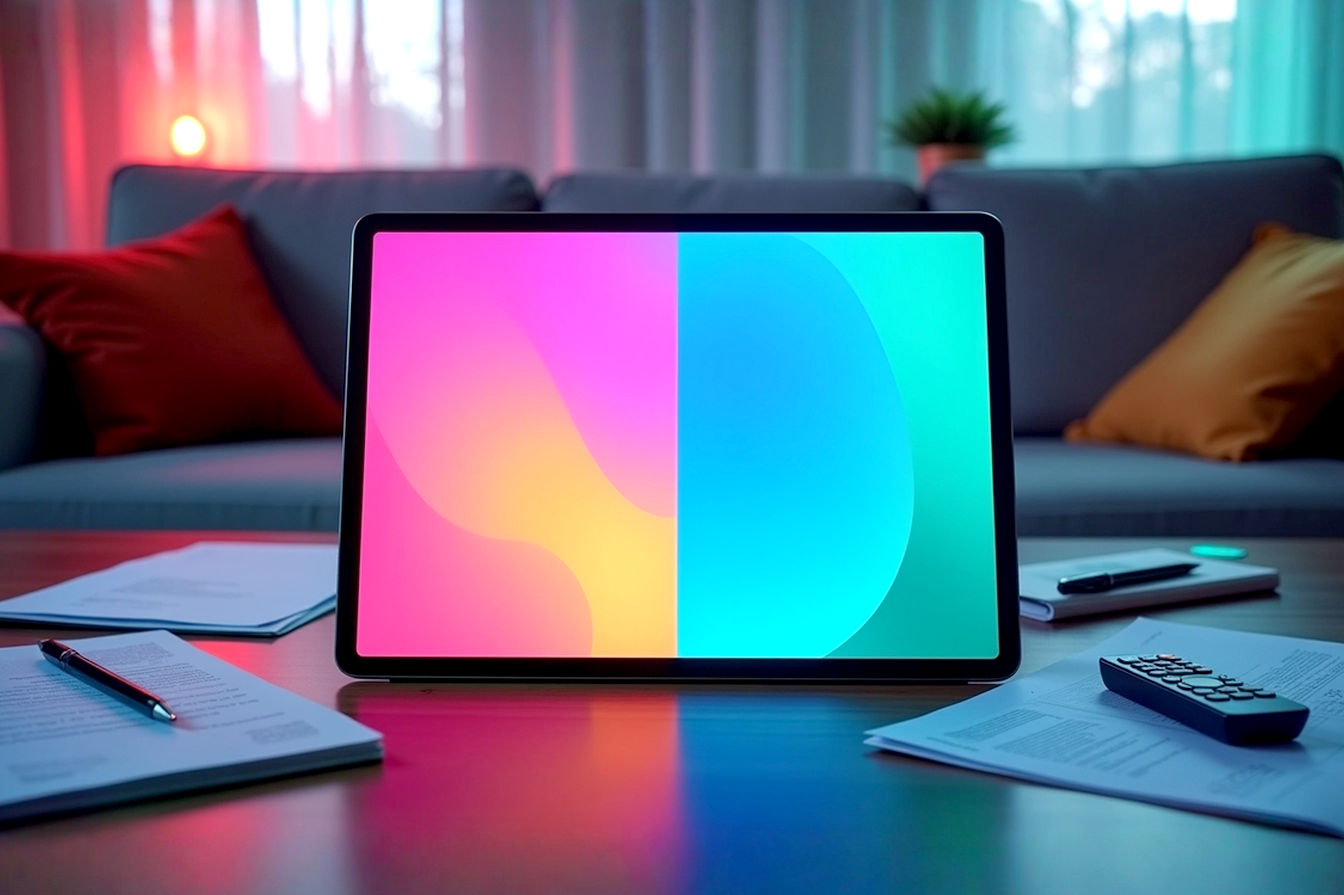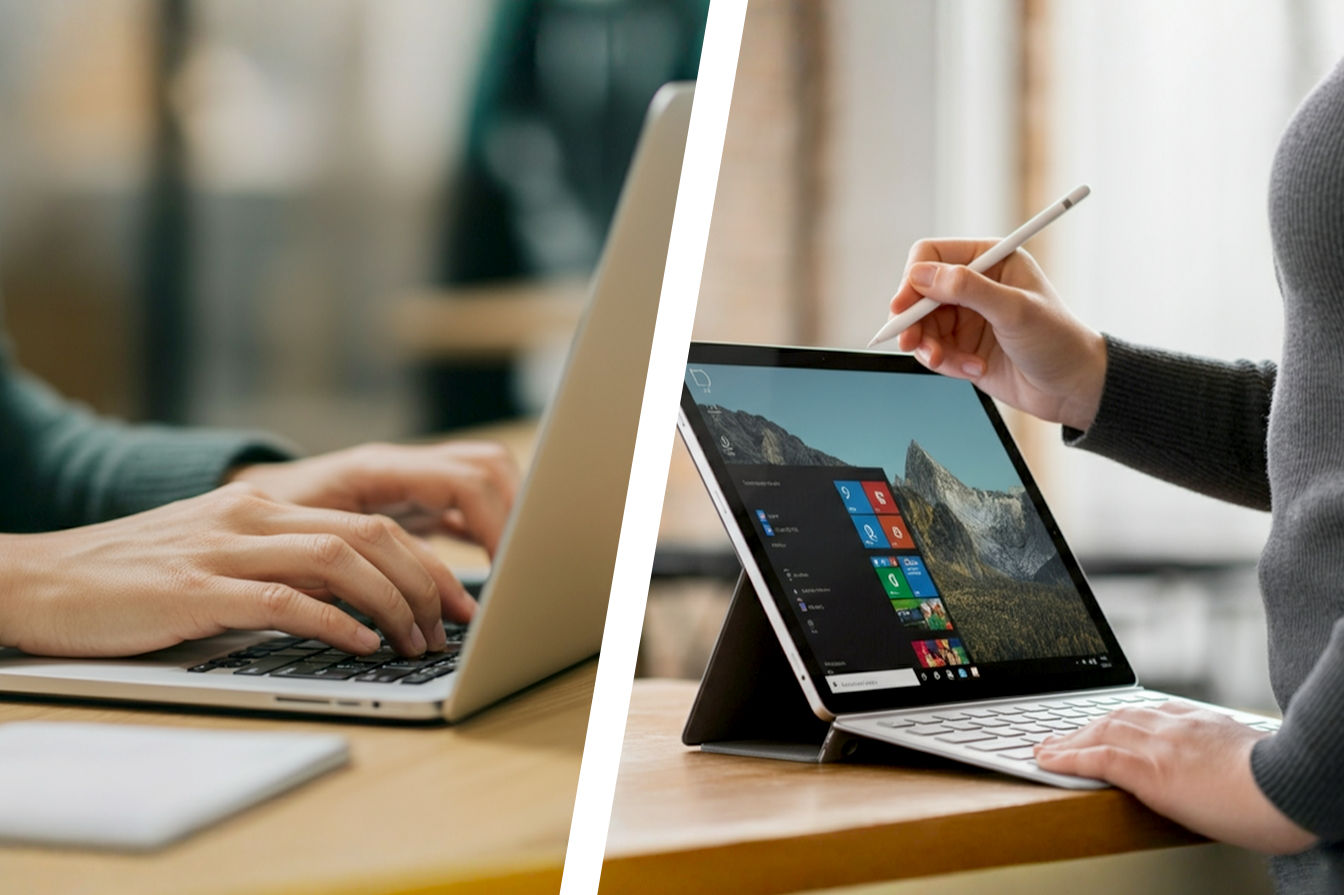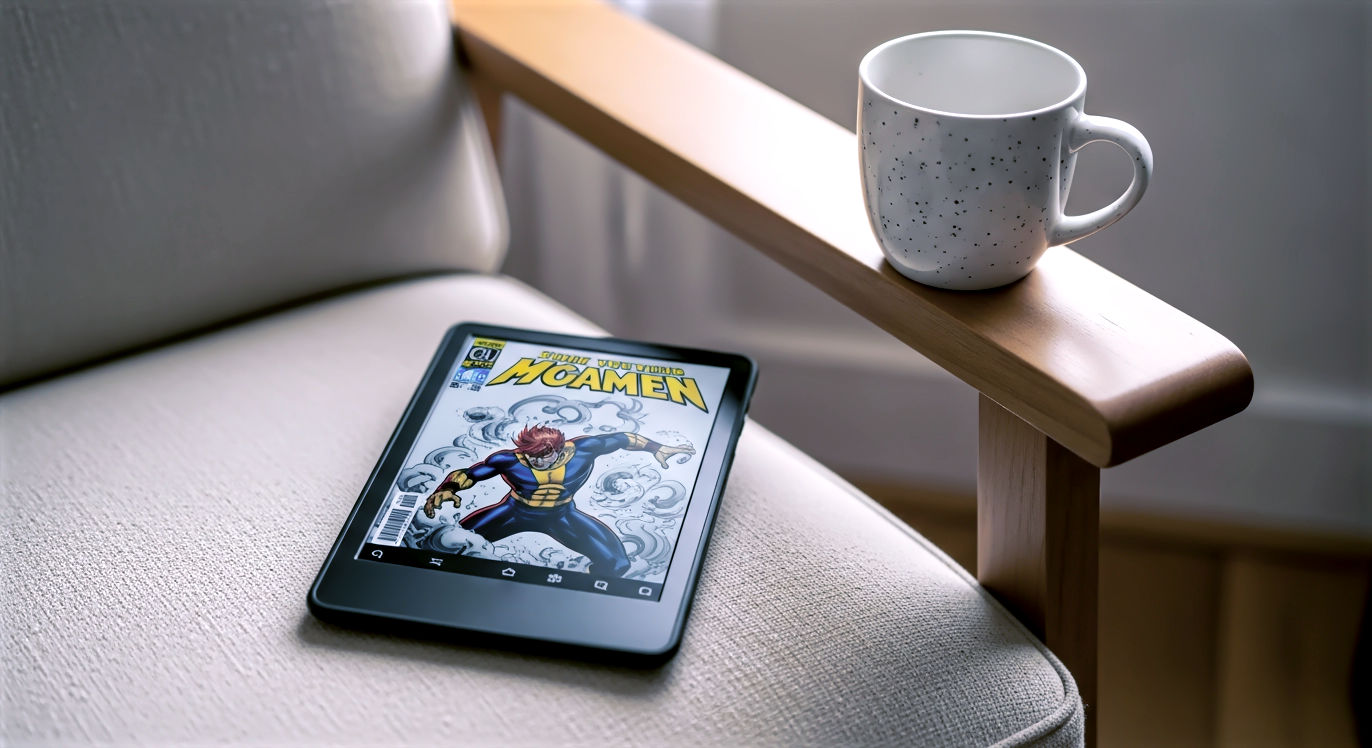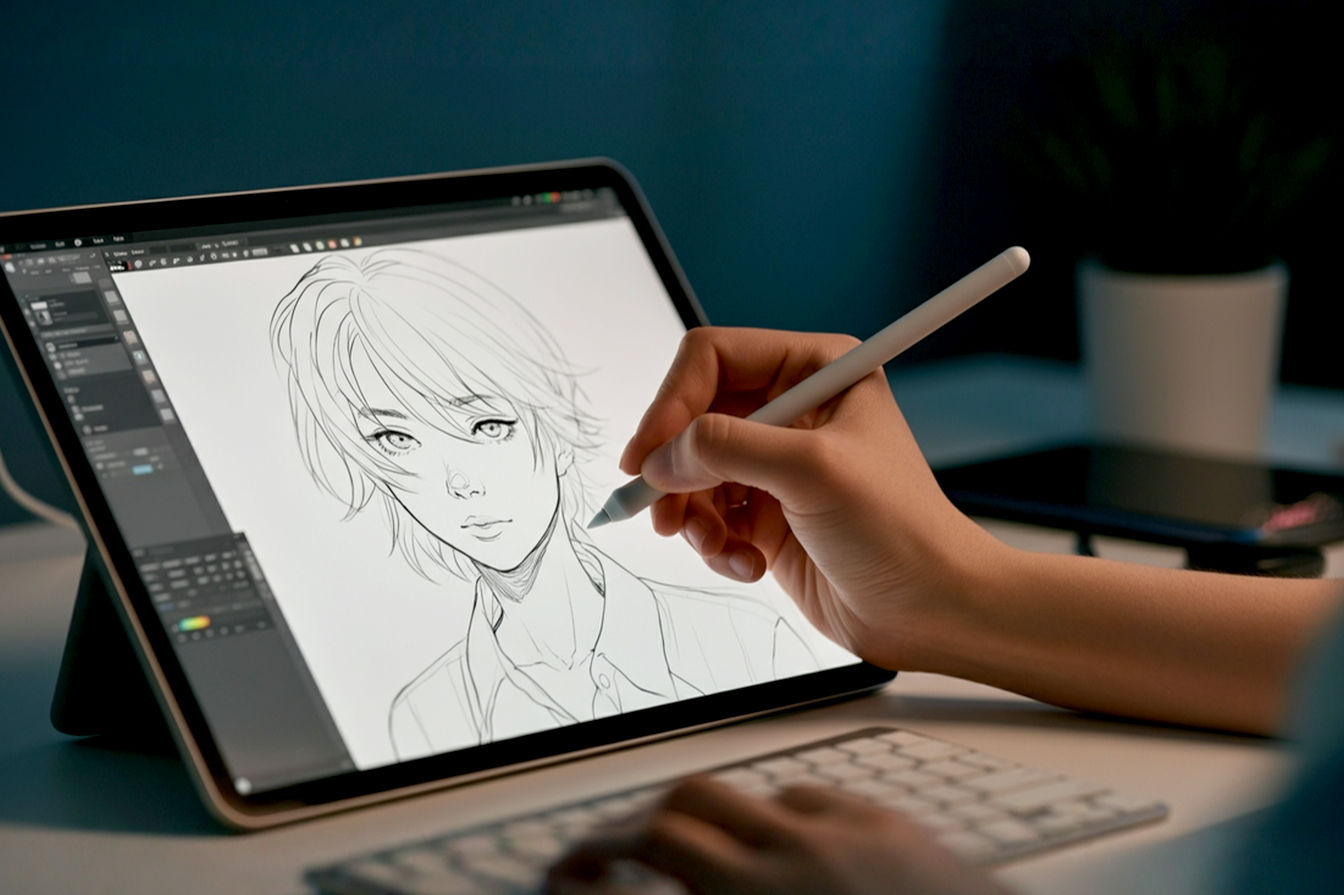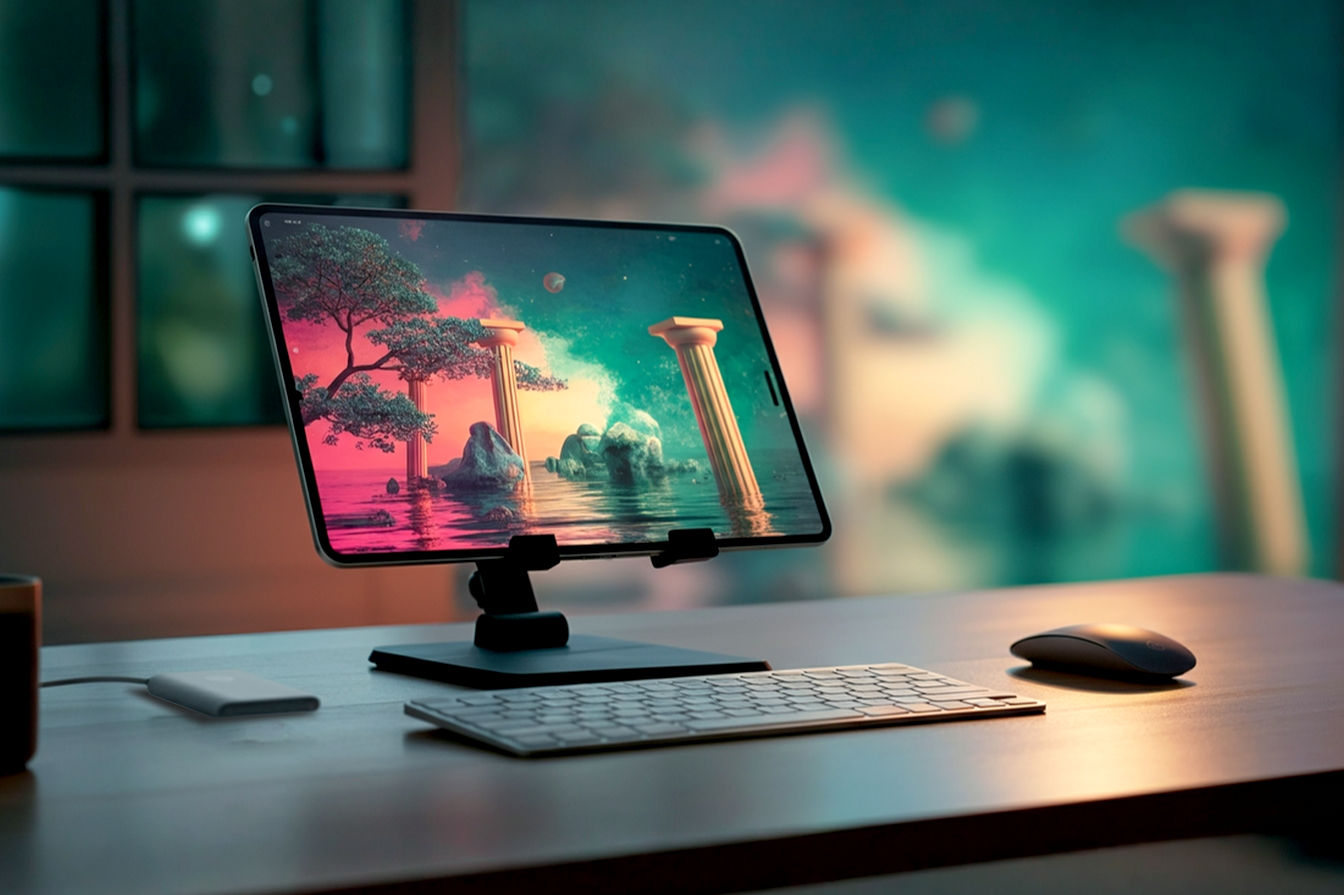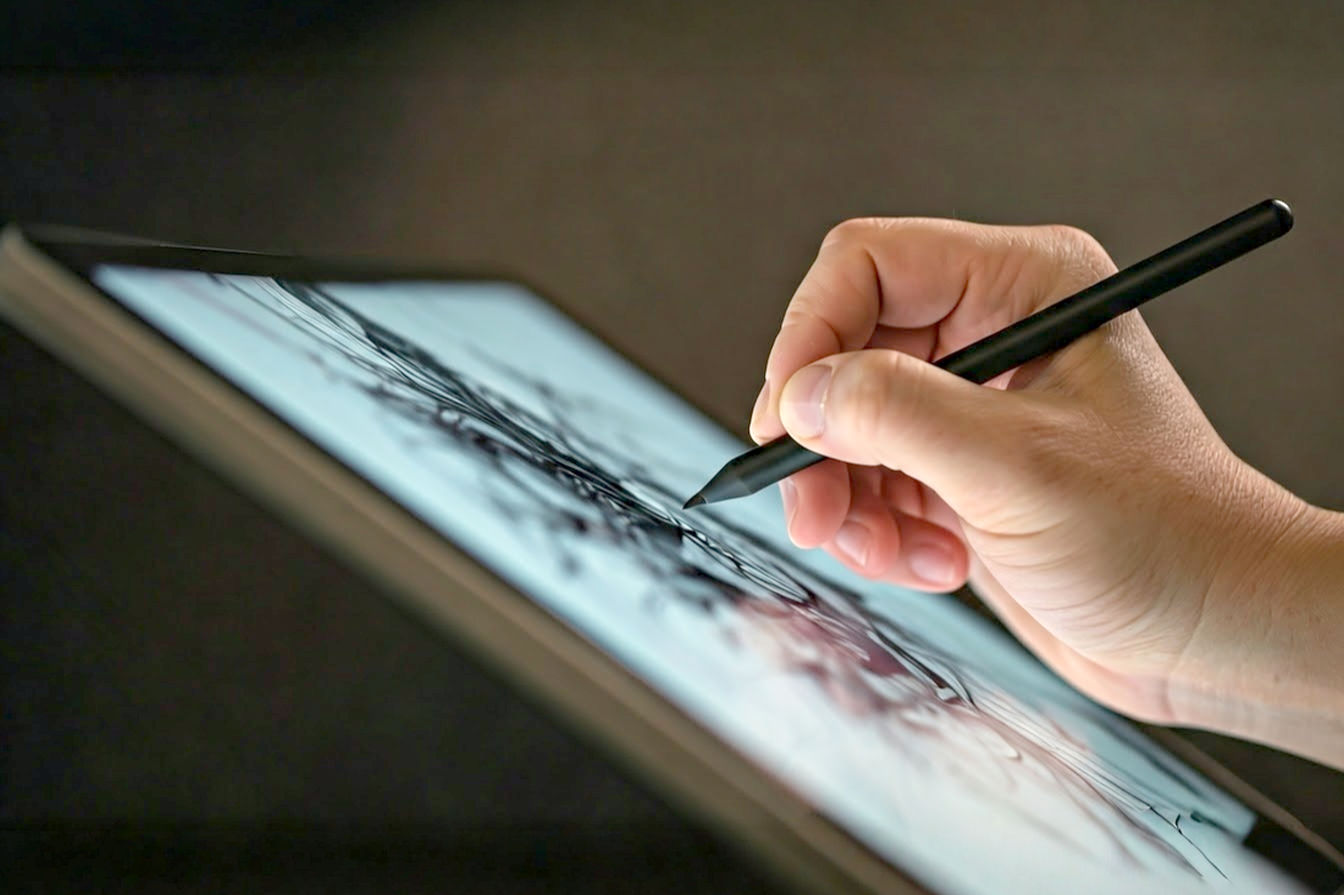This post may contain affiliate links. If you make a purchase through these links, we may earn a commission at no additional cost to you.
Introduction: Navigating the Modern Device Landscape
We live in a world packed with digital devices. Smartphones are always in our pockets, laptops are essential for work and school, and smartwatches track our every step. In this crowded space, the tablet device holds a unique position. It’s been around for a while now, evolving significantly since it first hit the mainstream. But with phones getting bigger and laptops getting lighter, you might wonder: what exactly is a tablet today, and is there still a place for one in your life? This article will break down everything you need to know about tablets, helping you figure out if one is the right tool for you in 2025 and beyond.
Defining the Tablet: More Than Just a Big Phone
At its core, a tablet is a portable personal computer. It’s designed primarily around a touchscreen interface. Think of it as sitting somewhere between a smartphone and a laptop in terms of size and function. It offers a larger screen than a phone but is generally more portable and simpler to use for touch-based tasks than a traditional laptop.
The Core Concept: Touchscreen Computing
The defining feature of a tablet is its touch-sensitive screen. This is the main way you interact with the device. Instead of relying on a mouse and keyboard like a desktop or laptop, you use your fingers or a stylus to tap, swipe, pinch, and draw directly on the display. This input method makes tablets intuitive for certain tasks, like browsing the web, reading, watching videos, and playing touch-optimized games.
Technically speaking, these touchscreens use various technologies to detect input. Early resistive touchscreens relied on pressure, requiring a firm press or a stylus to register contact between two layers. Modern capacitive touchscreens, however, are much more common. They use the electrical properties of the human body. A layer of conductive material on the screen creates an electrostatic field. When your finger touches the screen, it distorts this field, and sensors detect the location of the distortion. This allows for multi-touch gestures, like zooming in or out with two fingers, which are fundamental to the tablet experience.
Key Characteristics: Portability and Form Factor
Tablets are built with portability in mind. They are typically thinner and lighter than most laptops. Their flat, slate-like shape makes them easy to hold and carry. Screen sizes usually range from about 7 inches up to 14 inches or more, offering a much larger viewing area than a smartphone without the bulk of a laptop. This form factor makes them ideal for consuming media, reading e-books, and quick tasks on the go. They are designed to be comfortable to use while lounging on a couch or commuting.
A Brief History: From Sci-Fi Dream to Everyday Reality
The idea of a portable, flat computing device isn’t new. It actually has roots in science fiction and early computing concepts that predate modern tablets by decades.
Early Concepts and Prototypes
Visionaries imagined tablet-like devices long before the technology existed to build them practically. As far back as the 1960s, computer scientist Alan Kay proposed the “Dynabook,” a conceptual portable computer for children with a graphical interface. While never built, it outlined many features we see in tablets today. Fictional devices in shows like Star Trek and movies like 2001: A Space Odyssey also featured portable, screen-based communicators and data pads, capturing the public imagination.
In the late 20th century, companies began experimenting with pen-based computing. Devices like the GridPad in 1989 and Apple’s Newton MessagePad in the early 1990s explored using a stylus for input on a screen. Microsoft also developed “Windows for Pen Computing.” These devices, while innovative, were often bulky, expensive, and had limited functionality and poor handwriting recognition, preventing widespread adoption. They were foundational steps, proving the concept but highlighting the technological hurdles.
The iPad Era and Mainstream Adoption
The tablet landscape changed dramatically in 2010 with the introduction of the Apple iPad. It wasn’t the first tablet, but it was the first to truly capture the public’s attention and create a mass market. The iPad combined a large, responsive multi-touch screen with a user-friendly interface and access to a growing ecosystem of apps through the App Store. Its success spurred other manufacturers to enter the market, leading to the proliferation of Android tablets from companies like Samsung, Google, and others, as well as Windows tablets. This period solidified the tablet as a distinct device category.
Evolution and Diversification
Since the initial boom, tablets have continued to evolve. They’ve become thinner, faster, and more capable. Displays have improved significantly in resolution and color accuracy. Processors have become powerful enough to handle more demanding tasks. The market has also diversified, with tablets now available in various sizes, price points, and operating systems, catering to different needs and budgets. We’ve also seen the rise of 2-in-1 devices, which attempt to blend the tablet form factor with laptop functionality, often featuring detachable keyboards and stylus support as core features.
Anatomy of a Tablet: Understanding the Components
Like any computer, a tablet is made up of several key components working together. Understanding these parts helps explain why tablets perform the way they do and how they differ from other devices.
Displays: The Window to Interaction
The screen is arguably the most important part of a tablet. It’s where you see everything and how you interact. Tablet displays vary in size, technology, and quality.
LCD vs. OLED vs. Emerging Technologies (e.g., NXTPAPER)
Most tablets use either LCD (Liquid Crystal Display) or OLED (Organic Light Emitting Diode) technology. LCDs work by backlighting liquid crystals that twist to filter light and create colors. They are generally more affordable and can get very bright. OLEDs, on the other hand, use organic compounds that emit light when an electric current passes through them. Each pixel generates its own light, allowing for perfect blacks (by turning pixels completely off), higher contrast ratios, and more vibrant colors. However, OLED displays can be more expensive and may be susceptible to “burn-in” over time, though this is less of a concern with modern technology.
Beyond these, newer display technologies are emerging. NXTPAPER, developed by TCL, is one example. It’s an LCD-based technology but uses a matte finish and specialized layers designed to mimic the look and feel of paper. This aims to reduce eye strain and improve readability, especially for reading e-books, by reducing glare and blue light. While not as vibrant as OLEDs, these emerging displays offer different trade-offs, prioritizing eye comfort and a paper-like experience.
Resolution, Brightness, and Refresh Rate
Several factors determine display quality. Resolution refers to the number of pixels on the screen (e.g., 1920×1080 pixels). A higher resolution means a sharper, more detailed image. Brightness, measured in nits, indicates how bright the screen can get. Higher brightness is crucial for usability in bright outdoor conditions. Refresh rate, measured in Hertz (Hz), indicates how many times the screen updates per second. A standard refresh rate is 60Hz, but many modern tablets offer higher rates like 90Hz or 120Hz. A higher refresh rate results in smoother motion, which is noticeable when scrolling or playing games.
Processors and Performance: The Tablet’s Brain
The processor, or CPU (Central Processing Unit), is the tablet’s brain. It handles all the calculations and instructions needed to run the operating system and apps. Tablet processors are typically designed for efficiency to maximize battery life while still providing enough power for common tasks.
Technical details: Tablet processors often use ARM architecture, which is known for its power efficiency. High-end tablets feature powerful multi-core processors similar to those found in laptops, such as Apple’s M-series chips or Qualcomm’s Snapdragon platforms. These processors have multiple cores (e.g., quad-core, octa-core) that can handle different tasks simultaneously, improving multitasking performance. They also often include integrated graphics processing units (GPUs) to handle visual tasks like rendering graphics for games and videos. The performance of the processor dictates how fast apps open, how smoothly games run, and how well the tablet handles demanding tasks like video editing.
Memory and Storage: Keeping Your Data
RAM (Random Access Memory) is temporary storage that the processor uses to hold data for currently running apps. More RAM allows the tablet to run more apps simultaneously and switch between them more smoothly. Storage (often Solid State Drive or SSD) is where your operating system, apps, photos, videos, and documents are permanently stored. Tablets come with various storage capacities, from 32GB to 1TB or more. Choosing enough storage is important as it can’t typically be upgraded later, though some Android tablets offer expandable storage via microSD card slots.
Batteries: Powering Portability
Battery life is critical for a portable device. Tablets are equipped with rechargeable lithium-ion batteries. Their capacity is measured in milliampere-hours (mAh). A higher mAh rating generally means a larger battery and potentially longer battery life, though actual usage time depends heavily on screen brightness, processor usage, and connectivity. Tablet manufacturers optimize both hardware and software to maximize the time you can use the device between charges. Fast charging technology is also becoming common, allowing batteries to be recharged more quickly.
Cameras and Audio: Capture and Sound
Most tablets include front and rear-facing cameras. The front camera is primarily used for video calls and selfies, while the rear camera can be used for taking photos and videos. While tablet cameras are often not as advanced as those found in high-end smartphones, they are sufficient for scanning documents, casual photography, and video conferencing. Tablets also have built-in speakers, and many offer stereo sound for a better media experience. Headphone jacks are becoming less common, with Bluetooth audio being the preferred method for connecting headphones or external speakers.
Connectivity: Staying Linked
Tablets offer various ways to connect to the internet and other devices.
Wi-Fi and Cellular Options (4G, 5G)
All tablets include Wi-Fi connectivity, allowing them to connect to wireless networks at home, work, or public hotspots. Many tablets also offer an optional cellular connection (often referred to as Wi-Fi + Cellular models). These models have a SIM card slot and can connect to mobile data networks like 4G LTE or the newer, faster 5G networks, just like a smartphone. This allows you to access the internet even when Wi-Fi isn’t available, providing true on-the-go connectivity. However, cellular models are typically more expensive and require a separate data plan from a mobile carrier.
Ports and Bluetooth
Physical ports on tablets are often limited to keep the design thin and light. A USB-C port is standard on many modern tablets, used for charging, data transfer, and connecting accessories. Some tablets may also include a magnetic connector for attaching keyboards or docks. Bluetooth is a wireless technology that allows tablets to connect to a wide range of peripherals, including keyboards, mice, headphones, speakers, and styluses, without needing physical ports.
Operating Systems: The Software That Drives Tablets
The operating system (OS) is the software foundation of a tablet. It manages the hardware and provides the interface you use to interact with the device and run apps. The three main operating systems for tablets are iPadOS, Android, and Windows.
iOS (iPadOS): Apple’s Ecosystem
Originally, iPads ran iOS, the same operating system as iPhones. However, as iPads became more capable, Apple introduced iPadOS in 2019. While it shares a core with iOS, iPadOS includes features specifically designed for the larger screen and capabilities of the iPad, such as improved multitasking, better file management, and enhanced support for the Apple Pencil and external keyboards. iPadOS is known for its user-friendly interface, strong app ecosystem optimized for tablets, and tight integration with other Apple devices and services.
Technical details: iPadOS is built on a Unix-like foundation. It uses a sandboxed app model, meaning each app runs in its own isolated environment, which enhances security. It supports features like Split View and Slide Over for multitasking, allowing users to run and interact with multiple apps on the screen simultaneously. The operating system is highly optimized for Apple’s own silicon (A-series and M-series chips), providing excellent performance and power efficiency.
Android: Openness and Variety
Android is an open-source operating system developed by Google. It’s used by a wide variety of tablet manufacturers, including Samsung, Lenovo, and many others. This leads to a diverse range of Android tablets with different sizes, features, and price points. Android is known for its customization options and the vast number of apps available on the Google Play Store. While early Android tablet interfaces weren’t always well-optimized for larger screens, Google has made significant improvements in recent years with versions specifically designed for tablets and foldable devices.
Technical details: Android is based on the Linux kernel. It uses a more open architecture compared to iPadOS, allowing for greater customization by manufacturers and users. Android supports various multitasking features, though their implementation can vary between different manufacturers’ versions of the OS. The app ecosystem is massive, although the quality and optimization of apps for tablet screen sizes can be inconsistent compared to iPadOS. Android’s flexibility allows manufacturers to innovate with hardware, leading to unique tablet designs and features.
Windows: Bridging Tablet and PC
Tablets running Windows (like Microsoft’s Surface Pro line) offer a different experience. They run the full version of the Windows operating system that you’d find on a desktop or laptop. This means they can run traditional desktop applications in addition to touch-friendly apps from the Microsoft Store. Windows tablets often blur the lines between tablets and laptops, especially when paired with a keyboard cover. They are popular for users who need the portability of a tablet but also require the full power and software compatibility of a PC for productivity tasks.
Technical details: Windows is a proprietary operating system developed by Microsoft. Windows tablets use processors typically found in laptops (like Intel Core or Qualcomm Snapdragon X series), providing strong performance. The interface adapts to whether a keyboard is attached, switching between a touch-optimized tablet mode and a more traditional desktop mode. This dual nature is a key advantage for productivity but can sometimes make the touch experience less seamless than dedicated tablet operating systems.
Other/Emerging OS
While iPadOS, Android, and Windows dominate the market, other operating systems exist or are emerging for specific types of tablets or niche uses. ChromeOS, primarily known for Chromebooks, is also found on some tablet-like devices, offering a web-centric experience. Linux-based tablets also exist, often appealing to developers or users who want maximum control over their device.
The Tablet Ecosystem: Accessories and Enhancements
To extend the functionality and usability of tablets, a wide range of accessories is available. These can transform a tablet from a simple media consumption device into a tool for creativity or productivity.
Styluses: Precision Input
A stylus (like the Apple Pencil, Samsung S Pen, or Microsoft Surface Pen) is a pen-like input device that allows for more precise interaction with the touchscreen. Styluses are invaluable for tasks like drawing, sketching, digital painting, taking handwritten notes, and accurately selecting small items on the screen. High-quality styluses offer pressure sensitivity and tilt detection, mimicking the feel of traditional pens or brushes. This makes tablets powerful tools for artists and designers.
Keyboards and Cases: Productivity and Protection
Many tablets have optional keyboard attachments or keyboard cases. These accessories add a physical keyboard, making it much easier and faster to type long documents, emails, or code. When combined with a keyboard, a tablet can function much more like a traditional laptop, enhancing its productivity capabilities. Cases, in general, also provide protection against drops and scratches, and many include stands that prop up the tablet for easier viewing or typing.
Docks and Hubs: Expanding Connectivity
Since tablets often have limited built-in ports, docks and hubs are popular accessories. These devices connect to the tablet (usually via the USB-C port) and provide additional ports, such as USB-A, HDMI (for connecting to external displays), Ethernet, and SD card readers. Docks can turn a tablet into a more versatile workstation, allowing users to connect external monitors, hard drives, and other peripherals.
Tablet Use Cases: What Are They Good For Today?
Tablets excel in various scenarios, often bridging the gap between the quick convenience of a smartphone and the full power of a laptop.
Media Consumption: Entertainment on the Go
This is perhaps the most common use case. The larger screen size compared to a phone makes tablets excellent for watching movies and TV shows, streaming videos on platforms like Netflix or YouTube, and browsing photos. The portability means you can easily use them while traveling, commuting, or relaxing at home. Good displays with high resolution and vibrant colors enhance this experience.
Reading and Learning: Digital Content
Tablets are fantastic for reading e-books, digital magazines, newspapers, and comics. The screen size is comfortable for reading for extended periods, and features like adjustable font sizes and backlighting (or paper-like displays) improve the experience. Tablets are also widely used in education, providing access to digital textbooks, educational apps, and online learning platforms. Their interactive nature can make learning more engaging.
Creativity and Design: Digital Canvas
With the advent of precise styluses and powerful creative apps, tablets have become serious tools for artists, illustrators, and designers. They offer a portable digital canvas for drawing, painting, photo editing, and graphic design. The ability to draw directly on the screen is a significant advantage for many creative workflows. High-end tablets with powerful processors and accurate displays are particularly suited for these tasks.
Productivity and Work: Light Computing Tasks
While not always a full replacement for a laptop, tablets can be very capable for many productivity tasks, especially when paired with a keyboard. They are great for writing emails, managing calendars, creating presentations, and working with documents and spreadsheets using mobile-optimized office suites. Cloud storage integration makes it easy to access and work on files from anywhere. For tasks that don’t require heavy processing power or extensive multitasking with many windows, a tablet can be a convenient and portable work device.
Gaming: Mobile and Cloud Gaming
The large touchscreen is perfect for many mobile games, from casual puzzles to more graphically intensive titles. Tablets offer a more immersive gaming experience than smartphones. With the rise of cloud gaming services (like Xbox Cloud Gaming or GeForce Now), tablets can also be used to stream and play demanding console or PC games, turning the tablet into a portable gaming screen.
Smart Home Control
Tablets can serve as a central control panel for smart home devices. With dedicated apps, you can manage lights, thermostats, security cameras, smart locks, and other connected devices from a single interface. Placing a tablet on a stand in a common area makes it easily accessible for anyone in the household to control smart home functions.
Specific Industry Applications (Healthcare, Education, Retail)
Tablets are increasingly used in various industries. In healthcare, they allow medical professionals to access patient records and diagnostic images at the point of care. In education, they facilitate interactive learning and classroom management. In retail and hospitality, they are used for point-of-sale systems, taking orders, and providing information to customers. Their portability and touch interface make them versatile tools in professional settings.
Tablet vs. Laptop vs. Smartphone: Finding the Right Fit
Deciding whether you need a tablet often comes down to comparing it with the devices you already have or are considering: smartphones and laptops. Each has its strengths and weaknesses.
Portability and Convenience
Smartphones are the kings of portability, always in your pocket and ready for quick communication and information access. Laptops, while portable, are larger and heavier, designed for use at a desk or table. Tablets sit in the middle. They are more portable than laptops, easy to carry in a bag, and convenient for use in various positions. Their larger screen is better for comfortable viewing than a phone, but they aren’t as instantly accessible as a phone for quick checks.
Performance and Capability
Laptops generally offer the highest performance, capable of running demanding software for tasks like video editing, 3D modeling, and complex programming. Smartphones are powerful for mobile apps and everyday tasks but have limitations for heavy computing. Tablets vary widely in performance. High-end tablets can handle surprisingly demanding tasks, especially with powerful processors and optimized apps. However, they may still lack the raw power or software compatibility of a dedicated laptop for professional-level work in certain fields.
Technical details: The performance difference often comes down to the processors and the operating systems. Laptops typically use higher-wattage processors (like Intel Core i7 or AMD Ryzen 7) designed for sustained high performance. Tablets use more power-efficient mobile processors. While chips like Apple’s M-series blur this line, allowing tablets to achieve laptop-class performance, the software ecosystem and input methods can still create differences in practical capability for certain tasks. Full desktop operating systems on laptops also offer broader software compatibility compared to mobile-first operating systems on most tablets.
Input Methods and Ergonomics
Smartphones are designed for touch and one-handed use. Laptops are built around a physical keyboard and trackpad, optimized for typing and precise cursor control. Tablets are primarily touch-based but can be enhanced with styluses and keyboards. For heavy typing or tasks requiring precise mouse control, a laptop is generally more ergonomic and efficient. For drawing, sketching, or direct manipulation of on-screen elements, a tablet with a stylus excels. For quick browsing or media consumption, touch alone on a tablet is often sufficient and comfortable.
Cost Considerations
Smartphones range from budget-friendly to very expensive flagships. Laptops also have a wide price range, with powerful models costing significantly more. Tablets generally fall somewhere in between. Budget tablets are very affordable, while high-end tablets with powerful specs and accessories can approach or even exceed the cost of some laptops. Deciding on a tablet involves considering its cost relative to its capabilities and how it fits into your existing device lineup.
The Rise of 2-in-1 Devices
The increasing popularity of 2-in-1 devices (like the Microsoft Surface line or iPad Pro with Magic Keyboard) highlights the desire to combine tablet portability with laptop productivity. These devices can function as standalone tablets but also offer robust keyboard attachments that turn them into capable laptops. This form factor attempts to offer the best of both worlds, though they can sometimes compromise on the pure tablet experience (due to weight with the keyboard) or the pure laptop experience (due to smaller screen size or lapability).
Are Tablets Still Popular? Market Trends and Relevance in 2025
After an initial surge in popularity, the tablet market saw some fluctuations. However, in 2025, tablets remain a relevant and popular device category, though their role has become more defined.
Shifting Market Dynamics
The tablet market isn’t growing at the explosive rate it once was, but it’s stable and continues to see innovation. The initial novelty has worn off, and consumers are now more considered in their purchases, often buying a tablet for specific reasons rather than just because it’s a new gadget. The market has also become more segmented, with clear distinctions between budget tablets for basic consumption, mid-range options for general use, and high-end tablets targeting productivity and creative professionals.
Niche vs. Mainstream Appeal
While almost everyone has a smartphone, and many need a laptop for work or school, tablets serve both mainstream and niche purposes. They are mainstream for media consumption, reading, and casual use. They are niche for digital art, specific professional workflows, or as a secondary device for those who appreciate the form factor. The continued development of tablet-optimized apps and accessories reinforces their appeal for these specific use cases.
Factors Driving Current Popularity
Several factors contribute to the continued relevance of tablets in 2025. The demand for portable entertainment and reading devices remains strong. The increasing capability of high-end tablets, particularly with powerful processors and stylus support, makes them viable alternatives to laptops for certain creative and productivity tasks. The integration of tablets into educational institutions and various industries also drives demand. Furthermore, the convenience of a larger screen for video calls and remote work/learning has been highlighted in recent years.
Do YOU Still Need a Tablet? Making the Decision
Ultimately, whether you need a tablet in 2025 depends on your individual needs, habits, and budget. It’s not a necessary device for everyone, but for many, it can significantly enhance their digital life.
Assessing Your Needs: A Practical Checklist
Consider these questions to help you decide:
- How do you primarily consume media? Do you watch a lot of videos, read e-books, or browse the web extensively outside of quick phone checks? A tablet’s larger screen is better for this.
- Do you need a portable device for creative tasks? Are you interested in digital drawing, sketching, or photo editing with a stylus? Tablets with stylus support are excellent for this.
- Could a tablet handle some of your work or school tasks? Do you need to write emails, work on documents, or give presentations on the go, but don’t need the full power of a laptop? A tablet with a keyboard might suffice.
- Do you find your smartphone screen too small for certain activities? Do you often wish you had a larger screen for browsing, gaming, or video calls when a laptop isn’t convenient?
- Do you want a dedicated device for reading? While phones and laptops can read, a tablet (especially one with an eye-friendly display) can offer a more comfortable reading experience.
- What is your budget? Tablets come at various price points. Can you afford a tablet that meets your needs without sacrificing essential features?
- How does a tablet fit with your existing devices? Do you already have a capable smartphone and laptop? If so, a tablet might be redundant unless you have specific use cases where it excels. If you only have a phone, a tablet could be a great step up for many tasks.
When a Tablet Excels
A tablet is likely a good fit if you:
- Prioritize portable media consumption and reading.
- Are a digital artist or frequently take handwritten notes.
- Need a lightweight device for light productivity tasks on the go.
- Want a larger screen for gaming or video calls than your phone offers.
- Are looking for a dedicated device for specific tasks like smart home control or use in a particular industry.
When Other Devices Might Be Better
You might not need a tablet if you:
- Primarily use your smartphone for all mobile tasks and find its screen sufficient.
- Require the full power and software compatibility of a laptop for most of your computing needs.
- Do extensive typing or tasks that require precise mouse input regularly.
- Are on a tight budget and already have a smartphone and access to a computer.
- Find the idea of managing another device inconvenient.
The Role of Budget
Budget plays a significant role. If you only need a device for basic media consumption and browsing, an affordable Android tablet might be perfect. If you require more power, a high-quality display, and support for advanced accessories like a precise stylus and a good keyboard, you’ll need to consider higher-end tablets, which come with a higher price tag.
The Future of Tablets: What’s Next?
The tablet market isn’t stagnant. Innovation continues, pushing the boundaries of what these devices can do and how they fit into our digital lives.
Enhanced Performance and AI Integration
Expect to see tablets with even more powerful processors, capable of handling increasingly demanding applications. Artificial intelligence (AI) is also likely to play a larger role, enhancing features like handwriting recognition, image editing, multitasking, and personalized user experiences. Chips designed with dedicated AI acceleration hardware will become more common.
Technical details: Future tablet processors will likely feature more advanced Neural Processing Units (NPUs) or AI engines. These specialized cores are designed to efficiently handle machine learning tasks, enabling faster and more sophisticated AI features directly on the device without relying solely on cloud processing. This could lead to improvements in areas like on-device language processing, predictive text input, intelligent image analysis, and more dynamic performance optimization based on user behavior.
Evolving Display Technologies
Beyond current LCD and OLED, we might see wider adoption of technologies like mini-LED (offering better contrast than standard LCDs) or further advancements in paper-like displays for improved reading comfort. Flexible or foldable display technology, already seen in some smartphones, could also make its way into tablets, allowing for devices that can change form factors.
Greater Integration with Other Devices
Tablets will likely become even more seamlessly integrated with smartphones, laptops, and other devices within their respective ecosystems. Features like universal copy/paste, easy file sharing, and the ability to use the tablet as a secondary display for a laptop will become more common and refined.
New Form Factors
While the slate form factor will remain dominant, expect continued experimentation with 2-in-1 designs, dual-screen devices, and potentially entirely new ways of interacting with a portable touchscreen computer. The line between tablets, laptops, and even smart displays may continue to blur.
Conclusion: The Enduring Place of the Tablet
So, what exactly is a tablet device? It’s a versatile, portable computer centered around a touchscreen, bridging the gap between smartphones and laptops. It excels at media consumption, reading, specific creative tasks, and light productivity. Do you still need one in 2025? It depends on your lifestyle and how you use technology. While not a universal necessity, for many people, a tablet offers a unique combination of portability, screen size, and touch-based interaction that makes it an invaluable tool for entertainment, creativity, and getting things done. The market is mature, offering a wide variety of options to suit different needs and budgets, and ongoing innovation ensures the tablet will remain a relevant part of the digital landscape for the foreseeable future.

